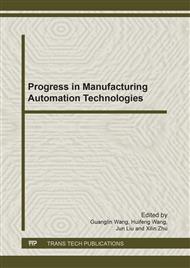p.88
p.92
p.96
p.101
p.107
p.112
p.117
p.122
p.129
Numerical Simulation for the Interaction of the Semi-Fixed Abrasive Plate with the Workpiece
Abstract:
In order to improve the efficiency of ultra-precision processing, the semi-fixed abrasive plate (SFAP) is developed to reduce or eliminate the surface and subsurface defects and improve the process efficiency. The interaction of the semi-fixed abrasive plate-workpiece is the key factor for the processing. The complex plate-workpiece interaction is taken into consideration in the generation of the semi-fixed abrasive surface in this paper. A numerical model which allows describing the elastic-plastic contact load of the isotropic fractal surface and the real contact area of plate-workpiece is developed for the semi-fixed abrasive plate. The results shows that the real contact area is only a part of the workpiece and it changed with the contact load alteration, it is useful to determine the processing parameter of SFAP lapping.
Info:
Periodical:
Pages:
107-111
Citation:
Online since:
July 2011
Authors:
Price:
Сopyright:
© 2011 Trans Tech Publications Ltd. All Rights Reserved
Share:
Citation:


